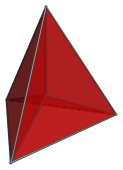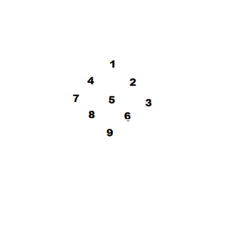Welcome to this week’s Math Munch!
Here’s something that sounds impossible: turn a single newspaper page into two rings, linked together, using only scissors and folding. No tape, no glue– just folding and a few little cuts.
Want to know how to do it? Check out this video by Mariano Tomatis:
On his website, Mariano calls himself the “Wonder Injector,” a “writer of science with the mission of the magician.” And that video certainly looked like magic! I wonder how the trick works…
Mariano’s website is full of fun videos involving mathe-magical tricks. I like watching them, being completely baffled, and then figuring out how the trick works. Here’s another one that I really like, about a fictional plane saved from crashing. It’s a little creepy.
How does this trick work???
Next up is one of my favorite number pattern — Pascal’s Triangle. Pascal’s Triangle appears all over mathematics– from algebra to combinatorics to number theory.
 Pascal’s Triangle always starts with a 1 at the top. To make more rows, you add together two numbers next to each other and put their sum between them in the row below. For example, see the two threes beside each other in the fourth row? They add to 6, which is placed between them in the fifth row.
Pascal’s Triangle always starts with a 1 at the top. To make more rows, you add together two numbers next to each other and put their sum between them in the row below. For example, see the two threes beside each other in the fourth row? They add to 6, which is placed between them in the fifth row.
Pascal’s Triangle is full of interesting patterns (what can you find?)– but my favorite patterns appear when you color the numbers according to their factors.
 That’s just what Brent Yorgey, computer programmer and author of the blog “The Math Less Travelled,” did! Here’s what you get if you color all of the numbers that are multiples of 2 gray and all of the numbers that aren’t multiples of 2 blue.
That’s just what Brent Yorgey, computer programmer and author of the blog “The Math Less Travelled,” did! Here’s what you get if you color all of the numbers that are multiples of 2 gray and all of the numbers that aren’t multiples of 2 blue.
Recognize that pattern? It’s a Sierpinski triangle fractal!
 If you thought that was cool, check out this one based on what happens if you divide all the numbers in the triangle by 5. The multiples of 5 are gray; the numbers that leave a remainder of 1 when divided by 5 are blue, remainder 2 are red, remainder 3 are yellow, and remainder 4 are green. And here’s one based on what happens if you divide all the numbers in the triangle by 6.
If you thought that was cool, check out this one based on what happens if you divide all the numbers in the triangle by 5. The multiples of 5 are gray; the numbers that leave a remainder of 1 when divided by 5 are blue, remainder 2 are red, remainder 3 are yellow, and remainder 4 are green. And here’s one based on what happens if you divide all the numbers in the triangle by 6.
 See the yellow Sierpinski triangle below the blue, red, green, and purple pattern? Why might the pattern for multiples of two appear in the triangle colored based on multiples of 6?
See the yellow Sierpinski triangle below the blue, red, green, and purple pattern? Why might the pattern for multiples of two appear in the triangle colored based on multiples of 6?
If you want to learn more about how Brent made these images and want to see more of them, check out his blog post, “Visualizing Pascal’s Triangle Remainders.”
Finally, I just stumbled across this collection of mathematical poems written by students at Arcadia University, in a class called “Mathematics in Literature.” They’re the result of a workshop led by mathematician and poet Sarah Glaz, who I met this summer at the Bridges Mathematical Art Conference. Sarah gave the students this prompt:
Step1: Brainstorm three recent school or other situations in your
present life – you can just write a few words to reference them.
Step 2: List 10-20 mathematical words you’ve used in class in the
past month.Step 3: Write about one of the previous situations using as many
of these words as possible. Try to avoid referencing the situation
directly. Write no more than seven words per line.
Here’s one that I like:
ASPARAGUS, by Sarah Goldfarb
An infinity of hunger within me
Dividing a bunch of green
Snap and sizzle,
Green parentheses in a pan
The aromatic property
Simplifying my want
Producing a need
Each fraction of a second
Dragging its feet impatiently as I wait
And when it is distributed on my plate
It is only a moment before zero
Units of nourishment remain.
Maybe you’ll try writing a poem of your own! If you do, we’d love to see it.
Bon appetit!












